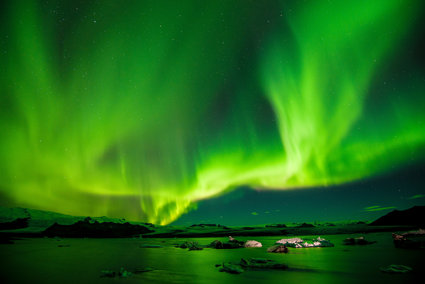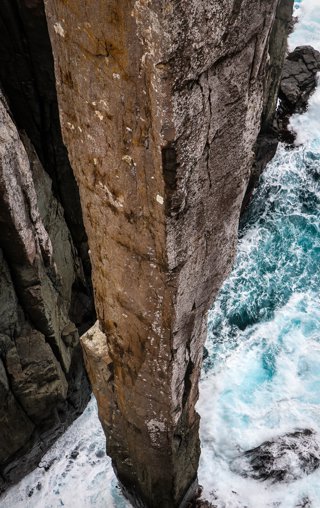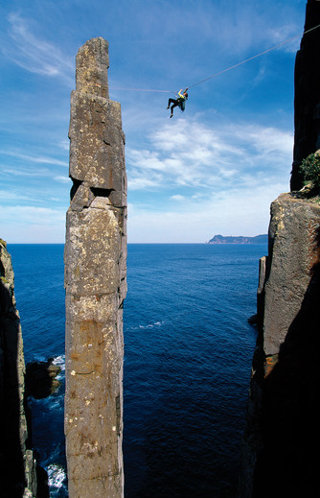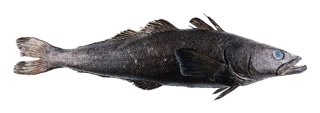
The totem pole and the toothfish
This lesson takes us to an extraordinary coastal stack teetering on the edge of the Tasmanian coast
The existence of this striking 65 metre stack defies all probability and has become an icon of climbing. In 2002, two Greenpeace climbers braved it to send a message: 'Pirate fishing trades away ocean life!' over the ocean to the south of Australia where massive amounts of pirate fishing is driving the long-lived toothfish towards commercial extinction.
Key questions
How do sea stacks form?
Why is the Totem Pole a Fantastic Place for climbers and others?
How do sea stacks form?
-
The base of the cliff is subjected to constant erosion from the waves. The main types of coastal erosion are corrosion, attrition, solution and hydraulic action
-
Over time the joints, faults and bedding planes in the base of the cliff become eroded and larger cracks appear
-
The cracks become wider and weaker as the erosion continues, causing caves to form. Caves are often found on headlands because wave erosion is particularly strong here. In some cases the roofs of caves may be broken through to form blowholes
-
When caves develop on opposite sides of a headland they will join up to form a natural arch, as the cliff is being eroded from both sides
-
The arch continues to be eroded and will gradually become bigger and bigger until just a slim pillar is left, attached to the top of the cliff
-
The top of the pillar collapses as it can no longer support the weight of the connecting rock, leaving behind a stack
-
The stack is then continuously eroded at the base by the waves, and eventually will be worn down until only a stump remains. These can become so eroded that they are only visible at low tide
-
Stumps will eventually be worn away until they remain constantly underwater as areas of shallow water, known as reefs
-
Over a period of hundreds of years this process will continue until all evidence of past landscapes has been eroded and coastal retreat occurs
Why is the Totem Pole a Fantastic Place for climbers and others?
The Totem Pole is part of the Tasman National Park, as it is part of the many miles of rugged coastline and diverse forest ecosystems, which contain several species of rare plant. The park also includes many small islands and the southern end of the park has some of the highest and most spectacular cliffs in Australia. The National Park is a very popular area for tourism as it is within a few hours drive of the main city on the island, Hobart. The Totem Pole is thought to be one of the hardest rock climbing routes in Australia, with hundreds of climbers attempting the climb every year. The global campaigning group Greenpeace which specialises in high-profile, non-violent demonstration used climbers to scale this icon to highlight the plight of the toothfish which suffers from pirate fishing. Toothfish is a popular dish in the United States - where it is sold as Chilean Seabass. The species is currently managed by the Commission for the Conservation of Antarctic Living Marine Resources, the body which introduced a catch and trade documentation scheme as an attempt to tackle illegal poaching of this species.
Links
Starter
What is the connection between these two images?




The link is that Greenpeace climbers scaled the Totem Pole in Tasmania, Australia to highlight attention to the pirate fishing trade during in 2002.
Download The Toothfish and Totem Pole PowerPoint for classroom use
Main Activity
How do sea stacks like the Totem Pole form?
Look at the coastal stacks fact sheets.
Use the information about the formation of coastal stacks in the fact sheets to add annotations to the PowerPoint explaining the physical processes that create stacks.
If you have access to a digital video camera you could create an animation or ‘claymation' video.
Could you write a piece of creative writing about climbing the Totem Pole using a photo of the Totem Pole as inspiration.
Paul Prichard suffered a serious accident while climbing the Totem pole. He wrote a book 'The Totem Pole: Surviving the Ultimate Adventure' which tells of the accident and his road to recovery.
File nameFiles
File type
Size
Download